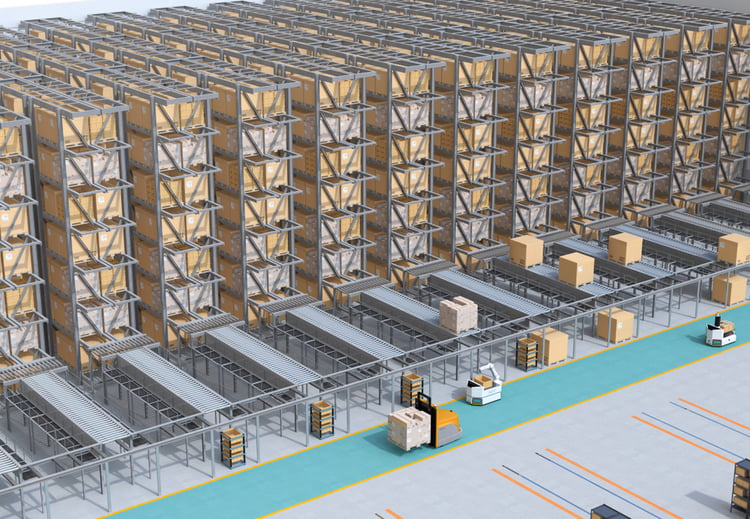Installing a microservice center (MFC) is a business decision that involves an initial investment and benefits over time. According to Marc Wulfraat president and founder of MWPVL International, a 12,000 m² MFC has a typical cost of US$5 million, but this can vary depending on site conditions. Laura Scott COO of Takeoff Technologies Inc., provided a comparable value of $3 million for a 10,000 m² MFC.
An MFC reduces the time and cost of order preparation, enabling faster sales and higher profits. According to global supply chain consulting firm Chainalytics, the typical cost per order is between $10 and $15 with manual picking, but an MFC reduces it to just $3 to $5. Thanks to automation, orders can also be processed faster: some microfulfillment systems have a throughput of more than 600 units per hour (UPH), while manual fulfillment is typically limited to below 100 UPH.
Are you planning an urban fulfillment center? Get a professional MEP design.
Same-day delivery was once a premium service, but it is now becoming a requirement for online retailers. According to Honeywell Inteligrado same day delivery is now expected by 56% of customers aged 18 to 34.
Advantages of MFC: faster collection and lower cost

MWPVL International published a case study that compares the costs of fulfilling orders for a bottle of ketchup using five different fulfillment strategies. For retailers, the lowest order processing cost is achieved when customers purchase products normally, as the order picking and final delivery steps are eliminated.
|
Order fulfillment method |
Retailer cost |
Paid working time |
|
In-store purchase (baseline) |
$0.08 |
12s |
|
1) Online purchase, manual collection and delivery by employee |
$0.79 |
114 seconds |
|
2) Online purchase, automated MFC pickup and 3rd party delivery service |
$0.43 |
64 seconds |
|
3) Online purchase, manual darkstore collection, third-party delivery service |
$0.50 |
76 seconds |
|
4) Online purchase, manual pickup from customer service center, third-party delivery |
$0.66 |
the 80s |
|
5) Online purchase, automatic separation at CFC, outsourced delivery |
$0.45 |
59 seconds |
*Cost to fulfill an order for a bottle of ketchup, with five methods. Source: MWPVL
Although this is just one example of one product, it demonstrates how shorter times are achieved when there is a dedicated online ordering facility (MFC or CFC) and the order picking process is automated.
These costs are reduced with curbside pickup (click and collect), as the customer assumes last-mile delivery. However, the supermarket must still bear the costs of collecting orders. The last two scenarios were not considered here since the curbside pickup option is not available.
|
Order fulfillment method |
Retailer cost |
Paid working time |
|
In-store purchase (baseline) |
$0.08 |
12s |
|
1) Online purchase, manual selection |
$0.49 |
71 seconds |
|
2) Online purchase, automatic MFC sorting |
$0.13 |
20s |
|
3) Online purchase, manual collection in the darkstore |
$0.20 |
33 seconds |
*Costs to fulfill an order for a bottle of ketchup, with curbside pickup. Source: MWPVL
When last mile delivery is removed, there is a significant reduction in the cost of fulfilling an order. A microfulfillment center has flexibility for different types of purchases, including click and collect and home delivery.
According to Satish Shukla , co-founder of Addverb Technologies, online sales are still a challenging segment for supermarkets as fulfilling an order can take up to 60 minutes. However, an MFC can reduce order picking time to just 6 minutes.:
- An MFC also reduces final delivery time as it can be deployed closer to customers thanks to its compact size.
- For a given sales volume, a new MFC costs about half the cost of a new supermarket, but inventory turnover can be three times higher.
What is the payback period for a microfulfillment center?
The initial cost and payback period of an MFC can vary, depending on available space and each retailer's needs. A payback period of 2 to 3 years is typical according to Steven Hornyak , CCO at Fabric. However, he also mentions how micro-fulfillment is now considered necessary by many retailers, regardless of the payback period – they simply need the technology to remain competitive.
Innovation Alert , provider of the Alphabot technology used by Walmart, also determined that MFCs can achieve a 24-month payback period. The market segment grew by 40% in 2020 alone, and they consider that manual harvesting will no longer be viable for online grocery sales in the near future.

